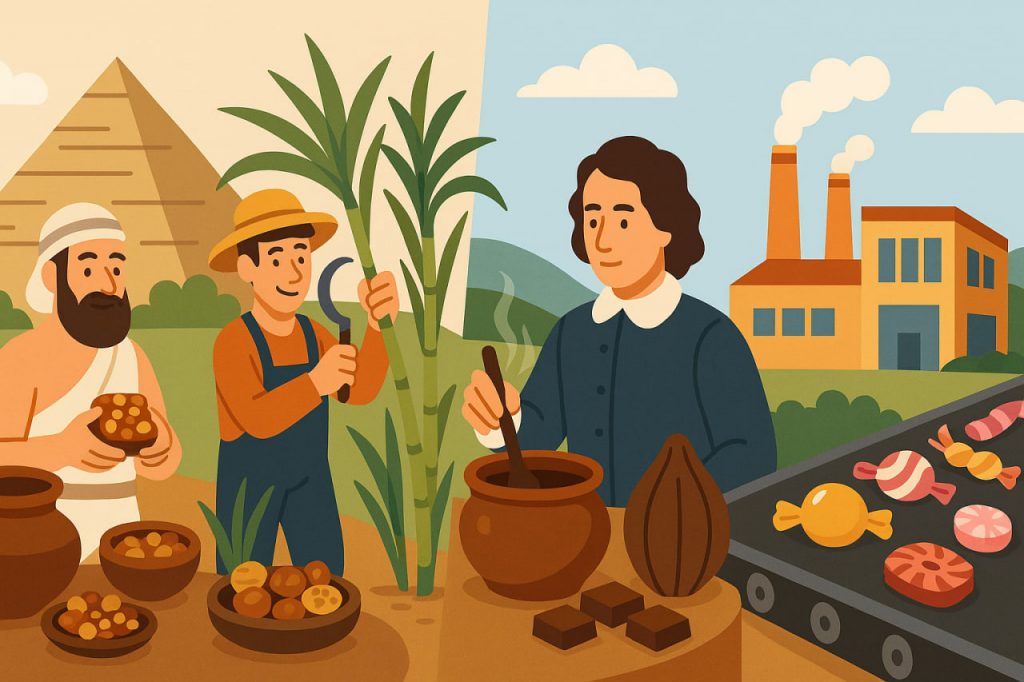Confectionery, the art of making sweet treats, has a rich history that spans thousands of years and many cultures. What began as natural sweets like honey and dried fruit has evolved into a global industry producing everything from chocolate truffles to gummy candies. The development of confectionery is closely tied to advancements in agriculture, trade, and technology. Over centuries, various civilizations developed their own styles of sweets, often linked to rituals, celebrations, or medicine. As sugar became more accessible, confectionery transitioned from elite luxury to everyday pleasure. Today, sweets are found in nearly every culture and continue to evolve with innovations in ingredients and presentation. The story of confectionery is both a culinary journey and a reflection of human ingenuity.
Ancient Origins of Sweet Foods
Long before refined sugar, early humans enjoyed sweets in the form of natural sugars. Honey was one of the first sweeteners used by humans and was often mixed with nuts or fruits. In Ancient Egypt and Mesopotamia, people made candies from dates, figs, and sesame seeds, sometimes shaped into decorative forms.
The first candies were more like preserved fruit or medicinal pastes. In China and India, sweet syrups from sugarcane were boiled and dried into hard pieces resembling early sugar candy. These early treats were often used in religious rituals or traditional healing, showing that confectionery had cultural and spiritual significance from the beginning.
The Rise of Sugar and Its Influence
The true revolution in confectionery came with the spread of sugarcane cultivation. Originally grown in India, sugarcane was processed into crystallized sugar as early as 500 BCE. Through trade routes, sugar reached Persia, the Islamic world, and eventually Europe.
By the Middle Ages, sugar was still rare and expensive in Europe, used mostly by nobility. Medieval cooks created marzipan, candied fruits, and early forms of nougat. In the Islamic world, syrup-based sweets like halva and sherbet became popular. As sugar production expanded in the Americas and Caribbean colonies, prices fell, making sweets more widely available.
European Confectionery and the Birth of Pastry Arts
During the Renaissance and Baroque eras, European chefs began to experiment with sugar in new ways. Royal courts in France, Italy, and Austria featured elaborate desserts, sugar sculptures, and caramelized creations. This period marked the rise of confectionery as an art form, blending culinary skill with visual beauty.
The invention of chocolate confections followed the introduction of cacao from the Americas. At first, chocolate was consumed as a drink, but by the 17th century, it began to be combined with sugar into early solid forms. French patisseries (pastry shops) and confiseries (candy shops) began appearing in cities, paving the way for modern sweets culture.
Industrial Revolution and Mass Production
The 19th century brought technological advances that transformed confectionery from artisan craft to mass industry. Steam-powered machines, roller mills, and later assembly lines allowed for the production of hard candies, chewing gum, and chocolate bars on a large scale.
This era gave birth to iconic brands like Cadbury, Nestlé, and Hershey’s, which popularized sweets across Europe and North America. Sugar was now affordable to the general public, and candies became common in childhood, holidays, and everyday life. The rise of packaging and branding also played a key role in turning confections into commercial products.
Modern Innovations in Sweets
Today’s confectionery market is vast and diverse, encompassing traditional sweets, sugar-free options, gourmet chocolate, and even functional candy with added vitamins. Modern science has introduced techniques such as aeration, gelatin use, temperature precision, and molecular gastronomy.
Globalization has also allowed sweets from around the world — such as Turkish delight, Japanese mochi, and Mexican tamarind candy — to gain international popularity. Meanwhile, the industry is facing challenges related to health, sustainability, and ethical sourcing of ingredients like cacao. Nonetheless, confectionery continues to delight generations with its mix of science, tradition, and imagination.
Conclusion
While confectionery offers joy and cultural value, it also raises significant health concerns. Many candies and desserts are high in refined sugar, which is linked to obesity, type 2 diabetes, and dental decay. Frequent consumption of sugary treats can disrupt healthy eating habits and contribute to chronic conditions.
Some mass-produced sweets also contain artificial additives, trans fats, and preservatives that may affect long-term health. For children, excessive sugar intake can lead to hyperactivity, poor concentration, and energy crashes. Public health organizations recommend limiting intake of added sugars and promoting awareness of hidden sugars in processed foods. Moderation and informed choices are essential for enjoying sweets without compromising well-being.
Glossary
- Confectionery — the craft of making sweet food, especially candy and desserts
- Sugarcane — a tropical plant used to produce sugar
- Mythical origins — legendary or religious stories that explain a food’s history
- Patisserie — a French bakery specializing in pastries and desserts
- Marzipan — a sweet almond paste used in candy and cakes
- Functional candy — sweets with added health ingredients or supplements
- Ethical sourcing — obtaining ingredients in a way that is environmentally and socially responsible


